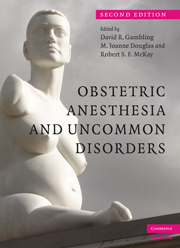Book contents
- Frontmatter
- Contents
- List of plates
- List of contributors
- Preface
- Section 1 Cardiovascular and respiratory disorders
- Section 2 Musculoskeletal disorders
- Section 3 Nervous system disorders
- Section 4 Metabolic disorders
- Section 5 Other disorders
- 17 Blood disorders
- 18 Infectious diseases in pregnancy
- 19 Dermatoses
- 20 Psychiatric disorders in pregnancy
- 21 Malignancy and pregnancy
- 22 Pregnancy and transplantation
- 23 Autoimmune diseases
- Index
- Plate Section
- References
18 - Infectious diseases in pregnancy
from Section 5 - Other disorders
Published online by Cambridge University Press: 19 October 2009
- Frontmatter
- Contents
- List of plates
- List of contributors
- Preface
- Section 1 Cardiovascular and respiratory disorders
- Section 2 Musculoskeletal disorders
- Section 3 Nervous system disorders
- Section 4 Metabolic disorders
- Section 5 Other disorders
- 17 Blood disorders
- 18 Infectious diseases in pregnancy
- 19 Dermatoses
- 20 Psychiatric disorders in pregnancy
- 21 Malignancy and pregnancy
- 22 Pregnancy and transplantation
- 23 Autoimmune diseases
- Index
- Plate Section
- References
Summary
Bacterial infections
Clinical features: fever and asymptomatic patient
Fever during pregnancy can result from a variety of infections, tissue trauma, malignancy, epidural analgesia, drug administration, and endocrine or immunologic disorders. Infection is the most common cause, reflecting the effect of pyrogens on the hypothalamus. Bacterial infections of the skin, periodontal tissues, respiratory and genitourinary tracts can lead to pregnancy-related complications such as preterm labor, premature rupture of membranes, abortion following pelvic inflammatory disease, chorioamnionitis, neonatal infections, cervicitis, urethritis, ectopic pregnancy, low birthweight, stillbirth, pneumonia, septicemia, and both maternal and neonatal death. Urinary tract bacterial infections usually arise from preexisting covert bacteriuria and experts recommend screening and eradication of these silent infections as routine prenatal practice. Antibiotic treatment during pregnancy is beneficial in reducing neonatal and maternal morbidity/mortality, and most bacterial infections are preventable and treatable. Clindamycin in early pregnancy can reduce the risk of preterm birth by 40–60%. Vaginal bacterial diseases are often asymptomatic and have little impact on management by the obstetric anesthesiologist. The more common bacterial infections and related complications are listed in Table 18.1.
Maternal and fetal implications
The incidence of maternal infection during labor has been estimated to be about 3%. Severe sepsis is less common, however, and presents as the primary problem in < 1% of patients. However, sepsis remains a significant cause of maternal death in underdeveloped countries. In pregnancy, there are decreases in immunoglobulin G levels, lymphocyte count, and impaired lymphocyte activity.
- Type
- Chapter
- Information
- Obstetric Anesthesia and Uncommon Disorders , pp. 321 - 342Publisher: Cambridge University PressPrint publication year: 2008



